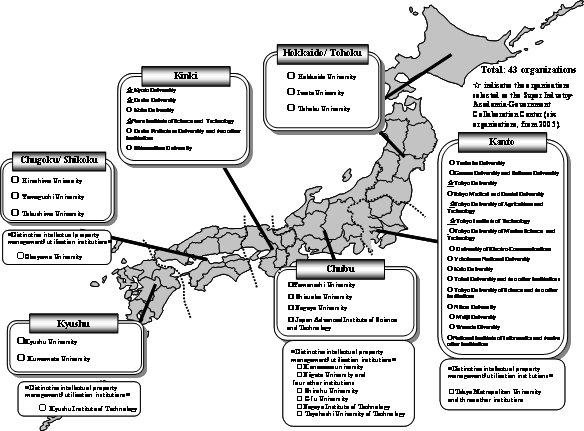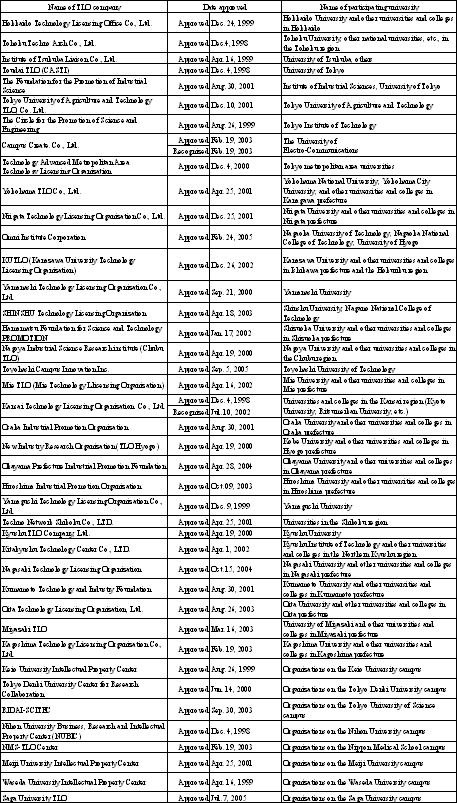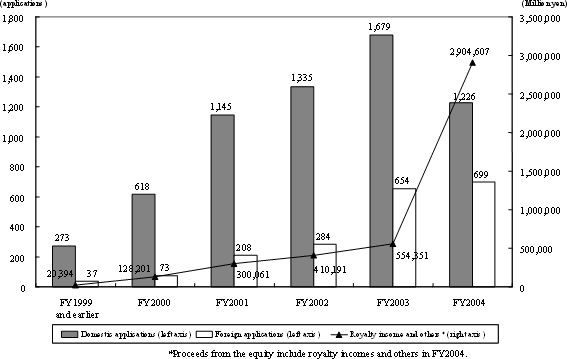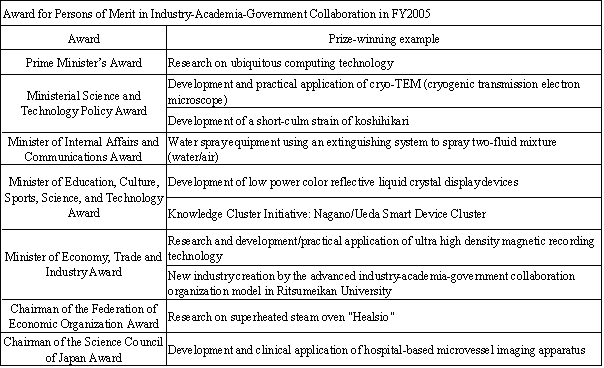3.3 Reform of Japan’s Science and Technology System
3.3.2 Strengthening of Industrial Technology and Reform of the Structure for Coordination between Industry, Academia, and Government
3.3.2.1 Promoting Commercialization for the Practical Use of Research Results Achieved by Public Research Institutions
(1) Introduction
● Promotion of cooperation among industry, academia, and government
The 21st century is being referred to as the “century of knowledge.” The creation and utilization of that knowledge is indispensable to Japan’s future development, for which the cooperation among industry, academia, and government is an important effort. Cooperation among industry, academia, and government in Japan has made great progress recently. For instance, the number of joint research projects between National Universities, etc. and industry has more than doubled in the last five years. In FY 2004, 223 patent licenses had been secured. In the past three years, over 490 university-based venture companies have been created. As of August 2005, there were 1,141 such venture companies. At the same time, however, the acquisition and execution of patents in Japan is not always sufficient, given the world-class R&D capabilities of Japanese universities. Future cooperation among industry, academia, and government must be promoted further, for which various efforts are being strengthened.
(2) Promoting Commercialization for the Practical Use of Research Results Achieved by Public Research Institutions
To encourage the practical use of research and development results obtained at universities, research institutions, etc., the JST offers a series of comprehensive programs covering the identification of exceptional research results, support for patent applications, and support for the commercial development of research results that are difficult to commercialize. The JST actively supports the patenting of research results obtained at universities, public research institutions and Technology Licensing Organizations (note1), as well as other technology transfer endeavors, and also runs the Technology Transfer Support Center, which is responsible for foundational work related to these activities, including the education of human resources and comprehensive consulting on technology transfer issues. The JST also promotes the following efforts based on the research results of universities and public research institutions: the implementation of a test to secure applied patents helpful for achieving practical use of fundamental patents; the modeling of new technology concepts from R&D-oriented medium-and small-scale enterprises; and the formation of venture corporations stemming from universities and public research institutions through the promotion of R&D aimed at the creation of new industries. Furthermore, in collaboration with universities, public research institutions, and TLOs, the JST provides development referrals for, and help with, licensing research results. For the development of new technologies considered likely to involve high development risk, JST assists companies developing applications for practical use by providing Risk-Taking Funds (if the development is unsuccessful, there is no requirement for repayment).
The Ministry of Education, Culture, Sports, Science and Technology supports university researchers who are attempting R&D that links basic research and research for product development─a stage of R&D that has insufficient support and is nicknamed “death valley.” The Ministry targets researchers whose research results can be expected to lead to entrepreneurial activities in the future, and subsidizes their R&D expenses and the management expenses for preparing a business plan toward the establishment of a business. As of the end of March 2005, MEXT has also placed 104 coordinators in 80 universities and technical colleges nationwide, where they serve as bridges between universities and enterprises that are conducting joint research at the universities. Furthermore, MEXT has been promoting the opening of special continuing education courses at universities and educational institutions to create human resources that turn research results into businesses after determining the nature of technology (Management of Technology or MOT) (note) and those that are experts in intellectual property. To foster human resources that are well versed in the securing and utilization of intellectual property, since FY2002, MEXT itself has been training human resources that will perform specialized jobs in the future at research locations, and equipping them with special knowledge about the securing and utilization of intellectual property as part of the “Fostering Talent in Emergent Research Fields,” program, which is supported with Special Coordination Funds for Promoting Science and Technology.
At RIKEN, in order to facilitate more efficient application of research results to practical use or technology transfer, a new system has been established. Under this system, researchers in RIKEN who have established venture companies on their own are given preferential treatment in their joint research with those venture companies.
The Ministry of Agriculture, Forestry and Fisheries supports activities of the TLOs approved by the Minister of Agriculture, Forestry and Fisheries, and is implementing a Technology Results Transfer Promotion Program for the practical application of research results of Incorporated Administrative Agencies for Experimental Research by industries.
The Ministry of Economy, Trade and Industry helps translate university research results into businesses through implementation of the Practical Application Research and Development Program for University-based Business Creation, which supports joint research by making matches between industry and academia with the objective of creating practical applications, and through the Dispatch of Management Experts Program for university-based start-ups. Aiming at the creation of 10,000 MOT personnel, since FY2002, METI has also been promoting the improvement of environments for the cultivation of MOT human resources. It does this by supporting the development of curricula and educational materials needed to cultivate MOT personnel at a total of 148 educational institutions such as universities.
In order to provide the appropriate protection of research results at national and public experimental research institutions and universities, and to support the smooth transfer of research results to industry, the Patent Agency hosts patent promotion fairs to provide opportunities for interaction with industries interested in adopting technologies. These fairs were implemented in 9 cities nationwide in FY2005. In addition, the National Center for Industrial Property Information and Training dispatches, as of the end of February 2005, patent promotion advisors to 33 of the 41 approved TLOs that are currently in operation.
In addition, the Patent Agency sponsors international patent promotion seminars for a broad range of researchers and students from universities and public research institutions, which bring together large groups of individuals who are experts in the transfer of technology both in Japan and abroad. The Patent Agency also implements basic and practical training on patent promotion and technology transfer necessary to promote the transfer of research results to industry.
The National Institute of Advanced Industrial Science and Technology inaugurated 18 venture companies in FY2005 to develop new industries and markets by utilizing their own technology seeds, eased regulations on side businesses, and enhanced support for intellectual property rights.
3.3.2.2 Developing an Environment for the Transfer of Technology from Public Research Institutions to Industry
With the aim of realizing a “nation built on intellectual property,” the “Basic Law on Intellectual Property” was established in 2002 and various efforts are being made by the whole government to realize the “Intellectual Property Strategic Program” based on the Law.
Public research institutions must clarify the responsibility of institutions and researchers to explain to society the content and results of their research, and must give importance to intellectual property as well as research papers as performance evaluation of their researchers. Currently, the institutions are promoting that patents are to be attributed to the research institutions in principle, in line with proposals in the Basic Plan. Accordingly, the number of preferential licenses extended to private sector organizations resulting from patents obtained through joint research between national experimental research institutions and private sector organizations has increased with every passing year.
In line with the shift of attribution of patent and other university research results from individuals in principle to institutions in principle, the Ministry of Education, Culture, Sports, Science and Technology has established the Research Organization of Information and Systems (43 organizations) and has been providing support since FY2003 in order to establish a strategic management system for control and utilization of intellectual property, such as patents, produced by universities. (Figure 3-3-7) Moreover, to promote strategic foreign patent procurement originated from university research, the JST is supporting the related costs (the Technology Transfer Support Center).
Based on the Law for Promoting University-Industry Technology Transfer (Law No. 52, 1998), 41 TLOs were approved at the end of March 2006. The number of secured patent licenses was 1,863 as of the end of March 2005. (Figure 3-3-8, 3-3-9).
To support TLO activities, the Ministry of Economy, Trade and Industry started issuing subsidies to TLOs in 1999 following the enforcement of the Law for Promoting University-Industry Technology Transfer. In response to the large burden that foreign patent applications are having on TLOs, METI started in FY2003 to help cover foreign application costs with expanded subsidies.
Furthermore, METI drew up the “Guidelines for preparing trade secret management policy at universities,” to enable universities to manage trade secrets to an appropriate extent under their own judgment, and to facilitate smooth technology transfer of universities research results to industry. The guidelines are being made widely known to university-connected individuals.
The National University Incorporation Law (Law No. 112 of 2003) lists the “promotion of diffusion and utilization of research results” as one of the businesses of national universities, and made it possible that investment in approved TLOs will further promote a virtuous cycle of intellectual property and the return of research results to society. In line with this, Niigata University was allowed to invest in approved TLO (Niigata TLO Corporation) in March 2006.
Table 3-3-7 Regional distribution of university intellectual property centers under the improvement program

Table 3-3-8 Approved TLOs (Total of 41 institutions)

February 2006:
41 institutions approved as TLOs, 2 institutions
recognized as TLOs

Figure 3-3-9 Trend in approved TLO patent applications and royalty income
3.3.2.3 Reform of Structure for Disseminating Information and Research Exchanges Aimed at Strengthening Coordination among Industry, Academia, and Government
(1) Increasing the Dissemination of Information
To promote the strengthening of coordination among industry, academia, and government, it is essential to bring about a state of common recognition between industry and public research institutions, including universities. For this reason, public research institutions, including universities, are making research results available to the public and providing information in a number of ways, including the presentation of research results, the release of annual reports and other publications, the submission of research papers to various academic societies and journals, and the disclosure of government-owned patents.
The Ministry of Education, Culture, Sports, Science and Technology and the Ministry of Economy, Trade and Industry, in cooperation with the Japan Science and Technology Agency and the New Energy and Industrial Technology Development Organization, sponsored “Innovation Japan 2005-University Fair,” a nationwide industry-academic matching event to disseminate the intellectual property of universities and public research institutions in the field of the most-advanced technologies, such as nanotechnology/materials, health care/biotechnology, information/IT, environmental technologies and manufacturing technologies, to industries, etc.
Furthermore, to contribute to the creation of new industries, the Ministry of Education, Culture, Sports, Science and Technology utilizes the JST to compile databases covering a broad range of R&D support data and research results data for wide availability over the Internet. Specific examples are the Directory Database of Research and Development Activities (ReaD) that compiles organizational data, researcher data, research theme data and research resource data from public research institutions, including universities, and the JST Science and Technology Research Result Database for Enterprise Development (J-STORE) that brings together and processes research results from public research institutions, including universities, etc., related patent information, for presentation in a readily understandable technology resource format.
Based on the “Facilitating research information infrastructure and its utilization in various occasions” shown in the “Basic Plan for Agriculture, Forestry and Fisheries Research” drawn up in March 2005, the Ministry of Agriculture, Forestry and Fisheries carries out the digital conversion of research results and other information contributing to the technology development of the agriculture, forestry, and fisheries industries, for wide availability over the Internet. Specifically, this involves the preparation of the Agriculture Information Search System known as Agropedia(Notes 28), which integrates and serves as a centralized source for the digital full text information database of reports from the Ministry’s experimental research incorporated administrative agencies, national and public experimental research institutions and the field of agriculture, forestry and fisheries in universities; domestic and international databases of agricultural literature; a database of meteorological satellite images, and a database of research topics being explored at experimental research institutions.
Notes 28:
Agropedia: Derived from “Agriculture” and “Encyclopedia.”
(2) Promotion of Research Exchanges
In recent years, research and development has increased in both sophistication and complexity, and has undergone an increase in the number of fields that are either interdisciplinary or are not included in any traditional discipline. To promote creative science and technology, it is critical to actively promote the development of infrastructures that allow such exchanges to be carried out, in order to promote personnel and material exchanges that extend beyond research institutions, and to efficiently and effectively utilize limited research resources. In addition, research exchanges are critical for the transfer of research results from public research institutions, including universities, to corporations, etc., and to encourage research by public research institutions, including universities, which reflects the needs of the corporations, etc.
● Joint research and contract research
The number of joint research projects between national universities and the private sector has steadily increased over time. The number of such projects including national, public and private universities exceeded 10,000 in FY2004 (Figure 1-2-30). Since the incorporation of national universities in April 2004 has made it possible for national universities to engage in flexible coordination between industry, academia and government activities in accordance with their individuality and characteristics, they are expected to further promote joint research and contract research programs.
Government ministries have implemented a number of measures to promote joint research through collaboration among industry, academia, and the government. Examples include the “Effective Promotion of Joint Research with Industry, Academia, and Government” program, with matching funds from the Special Coordination Fund for Promoting Science and Technology, newly begun in FY2002, and the “Project for Research Advancement in Agriculture, Forestry and Fisheries Utilizing Advanced Technologies” implemented by the Ministry of Agriculture, Forestry and Fisheries. In addition, the Ministry of Economy, Trade and Industry implemented the Practical Application Research and Development Program for University-based Business Creation…, promotion of coordination between industry, academia and government research through the most-advanced R&D test bed network established and operated by the National Institute of Information and Communications Technology the “Program for Industry-Academia-Government Development of Advanced Technologies,” within the “Program for Promoting Strategic Information and Communications Research and Development,” … , The Ministry of the Environment utilizes the Global Environment Research Fund. The above programs serve to promote integrated project research through coordination among industry, academia, and the government.
(3) Promotion of Personnel Exchanges
Currently, there are several programs in place to promote exchanges between researchers. Examples include the Government Guest Researcher Program implemented at various government ministries, and the Flexible Employment System for Research Personnel that promotes flexible and creative research activities by researchers at national experimental research institutions.
To bolster the reforms of the system of collaboration among industry, academia, and government laid down in the Basic Plan, in continuation from the previous year, the nationwide “Fifth Business-Academia-Government Collaboration Summit” was held in November 2005, sponsored by the Cabinet Office, the Ministry of Internal Affairs and Communications, the Ministry of Education, Culture, Sports, Science and Technology, the Ministry of Economy, Trade and Industry, the Japan Business Federation, and the Science Council of Japan. Taking “Study the Direction of New Development of Coordination between Industry, Academia and Government based on Pioneering Cases” as its theme, leaders of domestic universities and corporations were invited to the summit, and panel discussions were made. Participants adopted the “Fifth Business-Academia-Government Collaboration Summit,” calling for aggressive promotion of the fostering and securing of human resources in science and technology, deepening of full-scale collaboration among industry, academia and government, and support for research results transfer, university reform, support for regional science and technology promotion, strategic protection and utilization of intellectual property, and expansion of the government’s investment in research and development concerning science technology. In addition, in order to further promote collaboration among industry, academia, and government, the “Fourth Conference for the Promotion of Industry-Academia-Government Collaboration” was held in June 2005 and working-level consultations were held, and were attended by representatives of universities, research institutions, and TLOs. In the conference, outstanding examples of successful collaboration among industry, academia, and government that achieved remarkable success and contributed significantly to the promotion of such cooperative activities at universities and companies were recognized at the Third Awards Ceremony for Persons of Merit in Industry-AcademiaGovernment Collaboration, which included the presentation of the Prime Minister’s Award, the Minister of Education, Culture, Sports, Science, and Technology Award, and other awards given by relevant hosts (Table 3-3-10).
The implementation of research activity for the private sector, etc., by researchers from national experimental research institutions and faculties at national universities, etc., contributes to the promotion of science and technology in Japan by cooperation among industry, academia and the public sector, and serves as an opportunity to demonstrate and build upon the individual capabilities of researchers. For this reason, it is necessary to manage the authorization of side jobs smoothly in which researchers employed by the national government are engaged in tasks such as research and guidance for the private sector, etc., outside of working hours. With regards to faculty members of national universities, they are allowed to engage in side jobs at the discretion of individual universities as the national university incorporation on April 1, 2004 has removed them from being employees subject to the National Civil Service Law.

Figure 3-3-10 Recognition of Persons of Merit in Industry-Academia-Government Collaboration (FY2005)
(4) Response to conflict of interest
In promoting coordination between industry, academia and government, it is extremely important to appropriately deal with any “conflict of interest” that may arise in universities and research institutions on a daily basis. Special prudence is especially required in “clinical study and clinical tests.” For this reason, the Ministry of Education, Culture, Sports, Science and Technology held, in February 2006, the “Second Workshop on the Ethics of Clinical Study and Conflict of Interest.” The workshop studied guidelines for each university to draw up conflict-of-interest policies and management rules concerning clinical study, and strived to promote the sharing of knowledge between universities.
(5) Promotion of Public Utilization of Research Facilities
There is no question that research activities of science technology depend on the creativity of researchers. In the cutting-edge fields, however, there are aspects in which both quality and quantity of research results are influenced by research facilities used by them. For this reason, such facilities play an important role in research activities.
Among others, the development of large research facilities in cutting-edge fields makes a major contribution to the development of science and technology, but at the same time it’s crucial to make the most of these facilities in order to promote Japan’s R&D as a whole and aim to advance the levels of science and technology. In this regard, the Second Science and Technology Basic Plan stated that the development and management of research facilities requires a large amount of expenditure, and the public utilization of the facilities will lead to the creation of world-highest level results.” It is expected that public utilization of cutting-edge large research facilities by researchers in industry, academia and government in a wide range of science and technology fields will contribute to the creation of outstanding research results.
Based on the “Law for the Promotion of Public Utilization of the Specific Synchrotron Radiation Facility,” the Ministry of Education, Culture, Sports, Science and Technology is striving to develop a competitive environment for selecting users and research topics, and to enhance technical support to users as to Spring-8, the large synchrotron radiation facility with the world’s best performance. In FY 2005, the Organization for the Promotion of Synchrotron Radiation Research adopted approximately 1,180 research proposals for implementation at the facility. Significant results were made so far in research such as “Electric Structures of Boron-doped Superconductivity Diamond,” and the “Cubic Structure of Synthase which appropriately Prints Genetic Information to Proteins.” Furthermore, MEXT revised the “Law for the Promotion of Public Utilization of the Specific Synchrotron Radiation Facility” in order to utilize the framework for facilitating the common use of SPring-8 which has been creating research results in an efficient and effective manner, and to seek further research results. Specifically, the “Law for the Promotion of Public Utilization of the Specific Advanced Large Research Facilities” was enacted in May 2006. The law aims to promote the fair and efficient use of the facilities, by listing under law SPring-8 and next generation super computers whose development will start in FY 2006 as cutting-edge large research facilities, and designating the Institute of Physical and Chemical Research (RIKEN) as the developer of super computers, and having registered organizations independent of the facilities’ installer select and support their users.
In addition, the public use of large research facilities with high versatility owned by incorporated administrative agencies, etc., to the extent that their own missions are not disturbed, is also important to utilize Japan’s R&D potential. However, there are some problems with these research facilities in that basic information concerning their use, such as location, use purpose, opening hours, etc., are not provided sufficiently, and user support systems on the side of the facilities are not yet developed. For this reason, the “Law for Facilitating Governmental Research Exchange” was revised in May 2006, by which the government (MEXT) provides related information for promoting the public utilization of these research facilities. To support users, the program of strategic utilization of advanced large research facilities has been implemented since FY2005, and efforts to develop a better user support system are being made in order to expand new users, mainly from industry for the Earth Simulator etc.
3.3.2.4 Developing an Environment to Invigorate Research and Development-style Ventures
The promotion of private-sector research and development and the utilization of R&D results within the national government, etc. have played an important role in revitalizing the economy.
In the Small Business Innovation Research Program (SBIR), the relevant government ministries and agencies coordinate to increase the opportunities to provide small and medium-sized enterprises and so forth with subsidies, etc. Subsidies, business commissioning fees and so forth that are intended for small and medium-sized enterprises for the development of new technologies leading to the creation of new industries are designated as “special subsidies” and are applicable to this program. In FY2005, seven government ministries, namely the Ministry of Internal Affairs and Communications, the Ministry of Education, Culture, Sports, Science and Technology, the Ministry of Health, Labour and Welfare, the Ministry of Agriculture, Forestry and Fisheries, the Ministry of Economy, Trade and Industry, the Ministry of Land, Infrastructure and Transport, and the Ministry of the Environment designated a total of 58 subsidies as “special subsidies.” A target amount of approximately 31 billion yen in funds was supplied to small and medium-sized enterprises, through the coordination and cooperation of the government ministries.
Contacts
Research and Coordination Division, Science and Technology Policy Bureau
(Research and Coordination Division, Science and Technology Policy Bureau)




